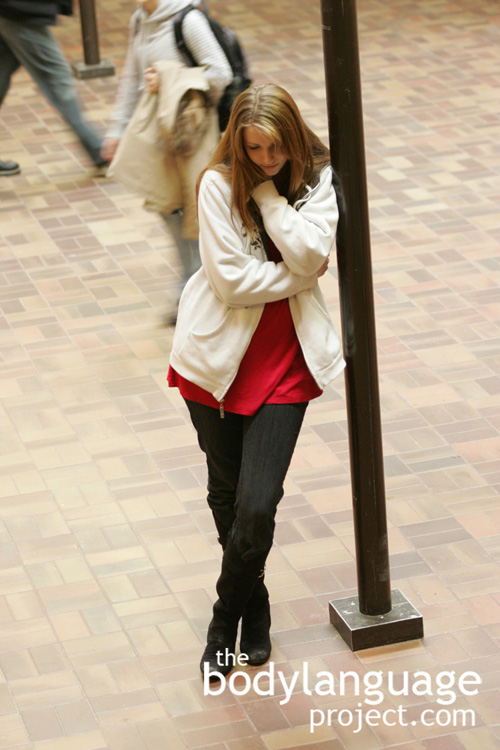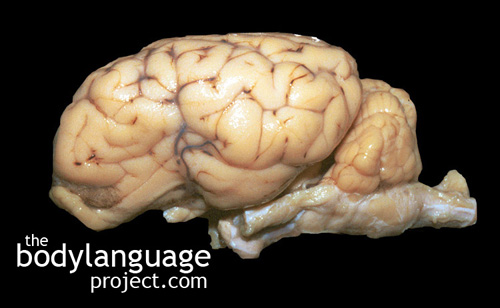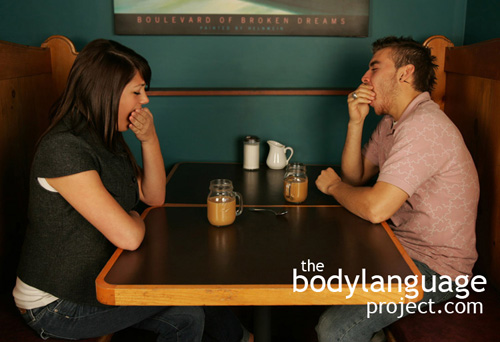
Are there enough cues to justify a conclusion in this case?
The rule of four, and it’s an important one, says that you can’t attach meaning to a single gesture and accurately judge a person. The rule of four calls on us to read cues alongside other cues commonly referred to as “cue clusters” before drawing conclusions. The more cues that appear in association with other cues, the more accurate one can be about the underlying meaning. It isn’t impossible to see cue clusters in the six’s and sevens or higher. However, most agree that four independent signals is enough to positively identify true meaning.
Sitting with arms tightly pressed against the chest can mean that a person is uncomfortable, but it can also mean that a person is cold! Scratching the nose or face can mean that a person is lying or it could actually have an obvious purpose; to alleviate an itch! However, touching the nose, wiping the mouth in a down-stroke, avoiding eye contact and fidgeting tells us that something dishonest is probably going on. Another example of a cue cluster is as follows: crossing the legs by bringing one foot over the opposite leg (the figure-four leg cross), fingers interlinked together (steepling), leaning back in the chair, and tilting the head back and looking down through the nose at others. This cluster shows arrogance and superiority. However, just the figure four, which is a mild crotch display on its own, means very little. The figure-four-leg-cross only tells us that the crotch has been put on display, but does not necessarily attach meaning to the gesture and indicate arrogance. To some, this posture might not even mean that, it just may be a comfortable way for them to sit.
In all cases, gestures are just gestures and nothing more. It is our targets, the creators, who, knowingly or accidentally, attach meaning or emotions to gestures; it is the senders who are in charge of the delivery phase, and we, as readers, who are in charge of the deciphering phase of the transaction. In other words, it is the sender who is responsible for the message and the meaning entirely, the reader is a passive entity that should never project meaning, especially from that which is not present. That’s not to say that a reader would try to create emotions inaccurately, as this would be counterproductive, but rather that it would be a mistake to bring a gestures to the consciousness of a target and then try to persuade them that their intentions are different from that which is actually true. In many cases, however, you may find that targets won’t be aware of their true emotions anyway and will generally be uncomfortable to be made aware of their subconscious gestures, so reads are best kept to one’s self. Just like you wouldn’t show your cards in poker game, you shouldn’t actively show off your body language skills. Reads, and the skills in this book, are much more powerful if kept a secret.
Not all body movement has hidden meaning either. Sometimes our bodies are quiet and do no talking at all. It is normal for novice readers of body language to immediately begin to see body language cues creep into consciousness, but it’s a mistake to assume that all gestures suddenly have hidden meaning and get carried away with reckless diagnosis.
Let’s take another cue cluster: arms crossed tightly over the chest, legs crossed, head down and shoulders pulled inward. Our conclusion here is that our target is uncomfortable and is closing off the outside world. As signals are removed from this cluster we can be less certain of their emotional origins. Legs crossed with head down can mean just about anything, but even if we add in shoulders pulled inward, it does not provide solid evidence of anything underlying. What we really need here is the fourth, the arms pulled in tight against the body, to really give us enough information to justify a conclusion. The other cues by themselves are closed body postures, but they can be due to other factors. Leg crossing can sometimes even demonstrate interest, as is the case when they are crossed toward a girlfriend or boyfriend (rather then away) for example. The rule-of-four says that we need a “preponderance of evidence”, a term borrowed from the civil judiciary system. We have preponderance of evidence, not when we have achieved absolute unquestionable or irrefutable data, but instead, happens when we have superior weight in our favour and in this case, four independent cues is plenty of weight.
This doesn’t mean that it’s impossible, or that we shouldn’t read people who only exhibit one or two cues. Reason being that the damage that might occur from an inaccurate read is likely very small so long as we keep it internalized. We can still make educated guesses or employ “working hypothesis” that can change with additional information as it is collected. One or two cues is sometimes all we get. Older people, who naturally have more controlled and subtle affect, and people learned at controlling their body language, such as public figures, only emit very subtle, fleeting or few nonverbal cues. In this subset of very controlled and practiced people, we often only see cues that are accidentally leaked, which in and of themselves are important, perhaps even more so then complete cue clusters in regular people. The caution here is to avoid premature conclusions on weak data especially when the stakes are high and that sometimes a gesture isn’t anything more than a gesture.
 Dr. Gurian believes there are about a hundred structural differences between the male and female brain. Men tend to compartmentalize their communication into smaller parts of the brain and therefore tend to get right down to the issues whereas women’s brains gather a lot more information from different areas of the brain and therefore tend to be more detailed in their conversations. Men also show more activity in mechanical centers of the brain and females show more activity in verbal and emotional centers. These changes happen very early in boys and girls. To a little girl, a doll becomes life-like with desires, feelings, needs or in other words a life, but to a little boy, that same doll is simply an object.
Dr. Gurian believes there are about a hundred structural differences between the male and female brain. Men tend to compartmentalize their communication into smaller parts of the brain and therefore tend to get right down to the issues whereas women’s brains gather a lot more information from different areas of the brain and therefore tend to be more detailed in their conversations. Men also show more activity in mechanical centers of the brain and females show more activity in verbal and emotional centers. These changes happen very early in boys and girls. To a little girl, a doll becomes life-like with desires, feelings, needs or in other words a life, but to a little boy, that same doll is simply an object.

